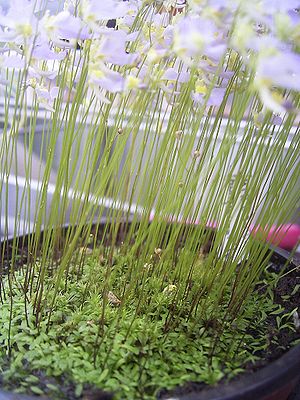Utricularia bisquamata
| Utricularia bisquamata | ||||||||||||
|---|---|---|---|---|---|---|---|---|---|---|---|---|

Utricularia bisquamata |
||||||||||||
| Systematics | ||||||||||||
|
||||||||||||
| Scientific name | ||||||||||||
| Utricularia bisquamata | ||||||||||||
| closet |
Utricularia bisquamata is a carnivorous plant from the genus of the water tubes in the section Calpidisca .
features
Utricularia bisquamata is an annual, terrestrial plant with a creeping habit. The emerald green, 1 mm narrow leaves reach a length of up to 1.5 cm and are rounded at the end of the leaf. The plant's traps sit on a short stem and reach a diameter of 1.0 to 1.5 mm. They can be found in a typical section on all vegetative parts of the plant. Tentacle- like appendages sit above and below the trap entrance .
The flowers appear singly or in groups of six on long, delicate stems and are two-colored. Different shapes from white flowers to flowers with a yellow point to flowers with a yellow and purple point are known. The flower size also varies from a few millimeters to one centimeter. The flowering time is from August to January , in Angola the species blooms from February to April . The seeds of the plant are only 0.25 mm long.
Distribution and habitat
Utricularia bisquamata is native to South Africa , Namibia , Angola and Madagascar . It lives in moist, open places with sandy or peaty soils, but also sphagnum cushions on rocks. In general, the plant can be found at altitudes of 0 to 1200 meters, locations up to 2250 m are also known for Angola.
Systematics
Utricularia bisquamata was first described by the German botanist Franz von Paula Knie in 1824 . Your type of epithet bisquamata means "two points" and refers to two prominent points on the petals . It is assigned to the Calpidisca section . With Utricularia pentadactyla is U. bisquamata directly related.
literature
- GI Cowan: Biota of South African wetlands in relation to the Ramsar Convention. Wetlands Conservation Program - Department of Environmental Affairs and Tourism 1999, ISBN 0-621-29461-6 , p. 22.
- Peter D'Amato: The savage garden. Cultivating carnivorous plants. Ten Speed Press, Berkeley CA 1998, ISBN 0-89815-915-6 , p. 225 ff.
- Robert Gibson: Drosera cuneifolia and D. admirabilis: Two rosetted sundews from The Cape Province, South Africa. In: Carnivorous Plant Newsletter. Vol. 31, No. 4, 2002, ISSN 0190-9215 , pp. 100-107 .